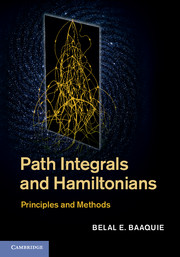Part five - Action with acceleration
Published online by Cambridge University Press: 05 April 2014
Summary
Introduction to part five
The most widely used actions in quantum mechanics have a kinetic term that is the velocity squared of the degree of freedom and a potential term that depends on the degree of freedom. The kinetic term fixes the equal time commutation equation of the degree of freedom, as shown in Section 6.7. Furthermore, the velocity term in the Lagrangian entails that all the possible indeterminate paths obey two boundary conditions, which in turn yields a state space that depends on the degree of freedom only. In Section 11.13, this property of the indeterminate paths was used for deriving the state function of the harmonic oscillator.
The action with acceleration has a kinetic term that is given by the acceleration squared of the degree of freedom, in addition to the usual velocity and potential terms. It is an example of higher derivative Lagrangians, discussed in Simon (1990). The higher derivative quantum systems have many remarkable properties not present for the usual cases studied so far.
The action with acceleration arises in many diverse fields and has been widely studied; it describes the behaviour of “stiff” polymers, of cell walls, of the formation of microemulsions, the properties of chromoelectric flux lines in quantum chromodynamics, as well as the Big Bang singularity in cosmology.
- Type
- Chapter
- Information
- Path Integrals and HamiltoniansPrinciples and Methods, pp. 271 - 272Publisher: Cambridge University PressPrint publication year: 2014



